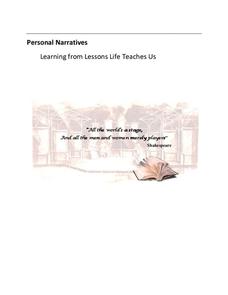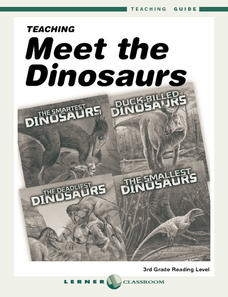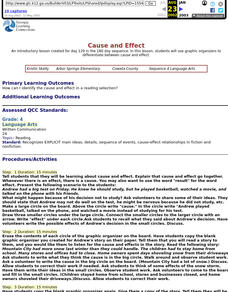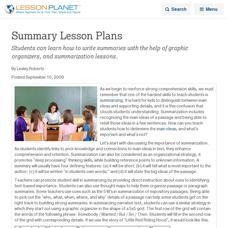Curated OER
Scrapbook of Evidence
Students read three different genres of fiction. They create a story map and brainstorm possible collage inclusions. Each student prepares a minimum of two scrapbook page entries for each text or passage. Students write beside each...
Curated OER
Topic, Detail, Response
In this main idea and details worksheet, students read a passage chosen by the teacher then fill in a 3 part graphic organizer with the topic, details supporting the topic and a personal response to the topic.
Curated OER
Key Idea Chart
In this "key idea" worksheet, students complete a "KIM" graphic organizer: key idea, information, memory clue. Students are given a sample organizer, then complete a blank one on as assigned topic.
Curated OER
Outlining Main Ideas and Details Adapted from: Expository Writing by Tara McCarthy
Learners examine articles from a number of sources to determine their main ideas and details, and discuss them as a class. Using a worksheet, they practice outlining a report after watching a teacher demonstration of the outlining...
Curated OER
The Last Word: Using Critical Thinking and Analysis to Reach a Decision
Want to explore the process of writing a persuasive essay and tie it in with the upcoming elections? Class members use Venn diagrams and the hamburger model of persuasive writing to write a five-paragraph essay on elections and...
Thoughtful Education Press
Personal Narratives: Learning from Lessons Life Teaches Us
"First Appearance," Mark Twain's tale about overcoming stage fright, serves as a model of a personal narrative and gets young writers thinking about milestones in their own lives. After examining student models and considering the...
Jen London
Building an Argument
Collect evidence and reasons and fill them in on this page to prepare for presenting an argument. Learners can evaluate what they are missing and make sure they fill in each line and bubble before considering their argument complete.
Lerner Publishing
Meet the Dinosaurs
Take your class of youngsters on a prehistoric adventure with this four-lesson series on dinosaurs. Accompanying the Meet the Dinosaurs books by Don Lessem, these lessons engage children in writing their own dinosaur books, making...
EngageNY
Types of Statistical Studies
All data is not created equal. Scholars examine the different types of studies and learn about the importance of randomization. They explore the meaning of causation and when it can be applied to data.
Curated OER
Worksheet for Choosing a Research Paper Topic & Developing a Thesis Statement
How do you choose a research topic? This helpful graphic organizer is provided to aid middle and high schoolers in organizing their initial thoughts and choosing a topic. They have to narrow their topic by culture, time frame, event,...
Curated OER
Introducing Literary Elements in Fiction
Identify literary elements in fiction. In this reading comprehension lesson plan, learners read the book Pigsty and record literary elements onto a graphic organizer. They specifically discuss the main characters and events in the text.
Curated OER
How Do Living Things Form Communities?
In this communities worksheet, students will write down 1 main idea about communities formed by living things. Then students will brainstorm 3 details to support their main idea. This worksheet is a graphic organizer.
Curated OER
Public Service Graphic Design
Twelfth graders create a billboard design (on the computer) to promote and increase awareness of a social problem. Students conduct research of public service issues that are of interest to them. They collect photos and images through...
World Intellectual Property Organization
Learn from the Past, Create the Future: Inventions and Patents
3D printers, selfie sticks, smart watches. GPS, self-driving cars, YouTube. Imagine life without inventions. Believe it or not, these items were all invented in the last 10 years. Inventions, and the inventors responsible for them, are...
Curated OER
Cause and Effect
Fourth graders use graphic organizers to differentiate between cause and effect. They read a story independently and write the cause and effects in the graphic organizer.
Friends of Fort McHenry
A Just War or Just a War?
What, if anything, makes a war "just"? This is an interesting and important question to explore with your class, and you can utilize an excellent lesson plan to support your group inquiry. The American Revolution and the War of 1812 are...
Curated OER
Let Me Tell You About My Favorite Animal
Students create books about their favorite animals using graphic organizers.
Curated OER
Memories, A Connection to the Past
Students read four or more books. They make predictions before reading, complete a picture walk, read in partners and complete graphic organizers. Various graphic organizers are provided in English and Spanish.
Curated OER
Summary Lesson Plans
Students can learn how to write summaries with the help of graphic organizers, and summarization lessons.
Curated OER
Story Summaries; The Three Little Pigs
Students explore language arts by completing a graphic organizer in class. In this story structure instructional activity, students read the classic tale "The Three Little Pigs" and discuss the main characters, conflict and setting....
Curated OER
Kalahari Explorations
Students explore world geography by completing graphic organizers and researching the Internet. In this Kalahari desert instructional activity, students identify the geographic location, weather and creation of the Kalahari desert....
Curated OER
Physical Geography- Climate
Sixth graders explore different climates. In this compare and contrast lesson, 6th graders look at the differences in climates of America and Europe. Students use KWL charts and graphic organizers to record information about different...
Curated OER
Paragraph Writing
Third graders receive Gummi hamburgers. They discuss parts and structure of a (real) hamburger. Students dissect the gummi hamburger and rearrange the pieces. Students discuss the problems that would be caused by this with a real...
Curated OER
Animal Communication
Students use three nonfiction selections in order to investigate the concept of animal communication. They use a graphic organizer for the information as it is gathered in the reading.

























